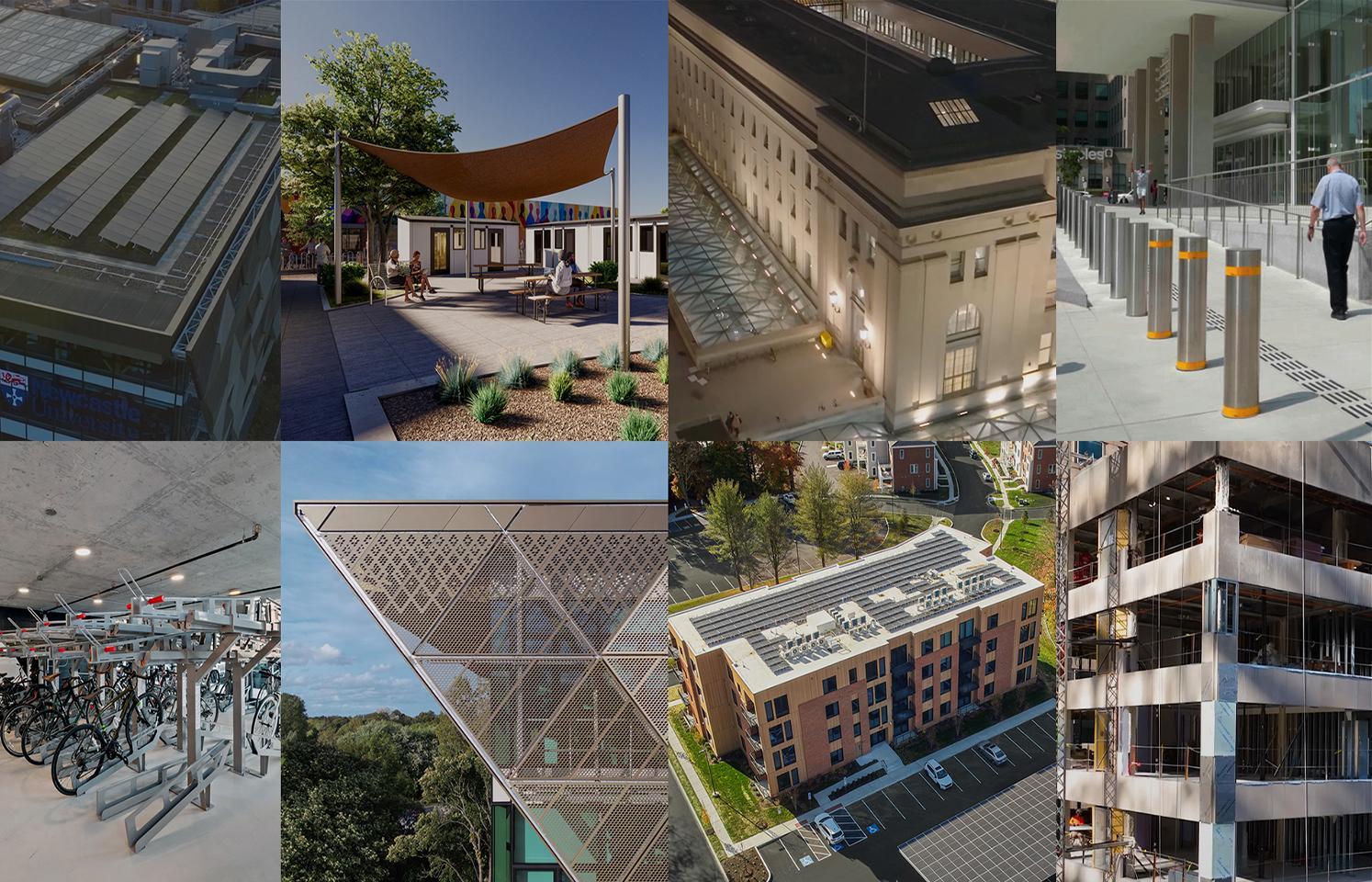55 Ways to Power a More Sustainable Built Environment
55 years of Earth Day. 5 years until 2030 climate goals. The built environment is at a turning point. With nearly 40% of global emissions coming from buildings and construction, architecture and engineering must lead the way in renewable energy adoption, material innovation and carbon-conscious design.
To kick off Earth Week, we’ve outlined 55 ways design, materials and renewable energy are shaping a low carbon future.
Renewable Energy, High-Performance Buildings & Distributed Energy Networks
How renewable energy is transforming the built environment:
1. Building-integrated solar PVs that passively generate clean, renewable electricity onsite.
2. Onsite electric vehicle infrastructure for reducing urban environments’ transportation emissions.
3.Geothermal heat pumps that use underground temperatures to regulate building energy loads.
4. Battery storage and microgrids that improve reliability, resiliency and reduce fossil fuel dependency.
5. District energy systems supplying multiple linked buildings with clean heating and cooling (bio-fuels).
6. Passive design strategies harnessing daylight and natural ventilation to reduce energy demand.
7. Façade designs optimized to respond to each site’s specific solar orientation and internal function.
8. High-performing, thermally broken envelopes with ultra-insulated materials limiting heat loss and gain.
9. Net-positive energy buildings that generate more clean energy than they consume.
10. Demand-response infrastructure that enables energy drawdown during peak loading periods.
Low-Carbon Materials & Circular Economy
How material choices reduce embodied carbon:
11. Mass timber construction sequestering carbon while reducing reliance on concrete and steel.
12. Low-carbon concrete and Portland Cement alternatives with reduced clinker content.
13. Recycled and upcycled materials (steel, glass, plastics) for structural and interior applications.
14. Modular construction and prefabrication reducing waste and energy use in manufacturing.
15. Carbon-negative building materials such as hempcrete and bio-based composites.
16. 3D-printed sustainable buildings and components optimizing material efficiency.
17. Salvaging and reusing structural components and materials from deconstructed buildings.
18. AI-driven material selection tools to optimize sustainability outcomes and life-cycle impact.
19. Lightweight, high-performance composites that reduce transportation emissions.
20 Closed-loop construction practices that achieve net zero waste outcomes.
Data, AI and Smart Technologies in Sustainable Design
How technology accelerates decarbonization:
21. Life Cycle Assessments (LCAs) driving early decision-making in design and procurement.
22. AI-powered energy modeling optimizing passive and active energy reduction strategies.
23. Digital twins for buildings so that actual operations achieve predicted performance results.
24. Smart sensors and IoT-enabled efficiency tracking for real-time energy management.
25. Building automation systems that adjust lighting, heating and cooling based on occupancy patterns.
26. Kinetic daylight and shade controls reducing artificial lighting needs and increasing outdoor connectivity.
27. Occupant feedback loops, enabling qualitative results supporting quantitative commissioning.
28. AI-driven urban planning optimizing land use, transportation and energy distribution.
29. AI-powered facilities management aiding landlords in promoting use of health-promoting evidence-based design approaches.
30. AI-enabled monitoring of health and effectiveness of biodiversity net gain strategies implemented.
Circular Cities, Infrastructure and Policy Shifts
How cities and policies are reshaping sustainability:
31. Adaptive reuse and retrofits extending building lifespans while cutting embodied carbon.
32. Deconstruction over demolition where materials are reused instead of discarded.
33. Design densities to enable car-free urban zones, prioritizing walkability, bikeability and transit.
34. Biodiversity net gain, using nature-based infrastructure solutions such as green roofs and bioswales.
35. Placing limits upon growth (horizontal expansion or sprawl) so nature has space to manifest and thrive.
36. Carbon disclosure mandates requiring reporting, reduction targets and offsetting.
37. Electrification of building systems eliminating fossil fuel use in HVAC&R equipment.
38. Sustainable master planning integrating renewables, district energy systems and green infrastructure.
39. LEED v5 and future certifications driving higher sustainability benchmarks towards net zero carbon.
40. Circular economy initiatives in both design considerations and construction waste management.
Conservation and Reforestation
Natural solutions for carbon sequestration:
41.Reforestation and afforestation as natural carbon sinks aligning with corporate sustainability goals.
42. FSC-certified forests supporting the highest levels of sustainable mass timber construction.
43. Urban tree canopies and green roofs reducing urban heat and runoff while improving air quality.
44. Nature-based carbon offsets to balance operational and embodied carbon in design and construction.
45. Fostering partnerships through local land trusts to bring awareness of natural ecosystems, fostering education and volunteerism.
Resilient and Future-Ready Building Design
How design decisions future-proof the built environment.
46. Designing for climate resilience with flood-resistant and heat-adaptive strategies.
47. High-performance operable glazing reducing thermal loads, while maintaining access to light and air.
48. Water-efficient building systems such as greywater recycling and rainwater harvesting.
49. Areas of refuge planned in buildings, emergency notification systems, and first aid supplies stored on site with training provided.
50. Resilient electrical systems incorporating microgrids, smart grids and backup power redundancy.
51. Electrification of building systems reducing dependency on fossil fuels, tied to onsite renewables.
52. Community-driven sustainability initiatives fostering public engagement in green design and operations.
53. Net zero energy retrofits extending the life and performance of existing buildings.
54. Advancing research into carbon-storing materials for construction, as well as sequestration in operations.
55. Integrating renewable energy master planning to support community-wide decarbonization.
Explore our sustainability journey and other insights.

